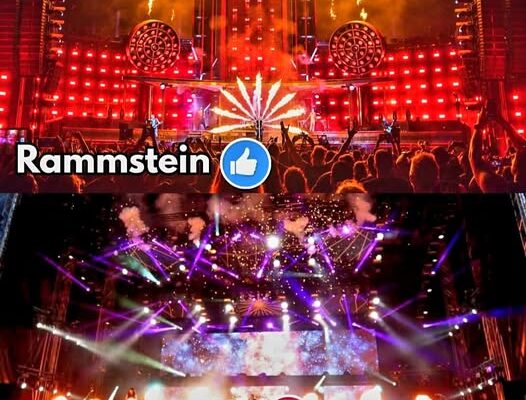Fire Meets Fantasy: Rammstein and Nightwish Prove Why Europe Still Rules Symphonic and Industrial
When it comes to musical genres that blend power, theatricality, and sheer emotional impact, Europe continues to reign supreme with bands like Rammstein and Nightwish showcasing why the continent remains the epicenter of symphonic and industrial metal. While both groups come from different stylistic backgrounds—Rammstein from the world of heavy, mechanized industrial metal and Nightwish from the lush, orchestral landscapes of symphonic metal—their dominance is proof that Europe has perfected the art of combining spectacle with sound. What unites these two bands, despite their differences, is their ability to transport audiences into a world that feels larger than life, where fire, fantasy, power, and drama meet in a perfect storm of artistry. Together, they represent not just music, but a cultural phenomenon that highlights the enduring strength of European metal on a global scale.
Rammstein has long been the embodiment of industrial metal taken to its most extreme conclusion. Formed in Germany in the mid-1990s, their rise coincided with the growing interest in heavy, electronic-infused metal that thrived on aggression and theatrics. Their stage shows are legendary, filled with flames, pyrotechnics, elaborate costumes, and performances that often blur the line between music and performance art. Every concert is a sensory overload, designed to shock, excite, and mesmerize, while the music itself provides the crushing backbone that keeps fans coming back. Songs like “Du Hast” or “Sonne” are built on relentless riffs, pounding rhythms, and Till Lindemann’s commanding voice, a mix of menace and theatrical charisma. Rammstein doesn’t just perform; they engulf their audiences in an experience that feels dangerous and exhilarating, making their live shows some of the most talked-about spectacles in modern music.
On the other side of the spectrum, Nightwish embodies fantasy in sound form. The Finnish group, often hailed as pioneers of symphonic metal, uses orchestras, choirs, and operatic vocals to create music that feels like a soundtrack to a cinematic epic. Founded by Tuomas Holopainen, the band brought together the power of metal with the grandeur of classical music, crafting soaring compositions that elevate the listener into otherworldly realms. Tracks like “Ghost Love Score” or “The Greatest Show on Earth” are not mere songs but multi-layered journeys through sound, blending symphonic arrangements with powerful guitar work and thunderous drums. With vocalists like Floor Jansen leading the charge, Nightwish has continued to set the standard for symphonic metal, captivating audiences with performances that feel both intimate and infinite, combining the vulnerability of human emotion with the scale of myth and legend.
What makes both bands so compelling is their shared mastery of spectacle and immersion. Rammstein uses raw physicality, fire, and mechanical soundscapes to create a world that feels apocalyptic and visceral, while Nightwish uses orchestral flourishes, ethereal themes, and epic storytelling to immerse fans in realms of fantasy and imagination. Both, however, share a distinctly European flair for artistry that elevates them beyond mere entertainment. Europe’s long cultural history of blending art, literature, and music into cohesive experiences provides fertile ground for these genres to thrive. The continent has always valued not just the sound of music but its ability to tell stories and create atmosphere, and both Rammstein and Nightwish embody this ethos in different but complementary ways.
The global success of these bands underscores Europe’s dominance in these genres. In North America, metal has historically leaned more toward thrash, hardcore, or the extremes of death and black metal, but Europe carved out a unique space for symphonic and industrial metal, developing subgenres that emphasize creativity, drama, and scale. Fans from across the world travel to see Rammstein’s explosive tours or Nightwish’s symphonic spectacles, cementing the idea that Europe remains the beating heart of these styles. Their influence can be felt worldwide, as countless bands attempt to emulate the theatricality of Rammstein or the orchestral depth of Nightwish, but few can capture the same balance of technical mastery and immersive power.
Another important aspect is the way both groups continuously evolve while staying true to their roots. Rammstein, despite being decades into their career, still manages to shock and innovate, pushing boundaries in both sound and stage design. Their commitment to provocation and intensity keeps them relevant and constantly discussed, ensuring their place not just as musicians but as cultural provocateurs. Nightwish, meanwhile, continues to refine and expand their symphonic approach, exploring new themes, experimenting with longer, more complex compositions, and never shying away from pushing metal into uncharted territories. Both bands are committed to growth, which keeps their music alive and their fanbases devoted.
The theatrical and immersive qualities of Rammstein and Nightwish also speak to something deeper about the European tradition in music: the importance of the live experience. While recorded music is vital, both bands thrive in concert settings, where their full visions can be realized. Rammstein’s shows are fire-fueled assaults on the senses, while Nightwish creates sonic landscapes that feel like stepping into a myth. The devotion of their fans is fueled by these performances, which often feel like communal rituals rather than just concerts. This cultural phenomenon extends beyond Europe, but it remains rooted in the continent’s approach to music as something more than entertainment—it is performance, storytelling, and identity all at once.
What makes the pairing of Rammstein and Nightwish particularly fascinating is how they represent two sides of the same coin. One is raw, industrial, mechanical power; the other is soaring, symphonic, and mythic. Yet both achieve the same goal: to transport their audiences into a different world, where the ordinary fades away and only the spectacle remains. Together, they highlight the versatility and range of European metal, which can embrace both the brutal and the beautiful, the primal and the poetic. This duality is what keeps fans enthralled and ensures that Europe continues to lead in genres that thrive on spectacle and imagination.
Ultimately, the success of Rammstein and Nightwish is not just about their music but about the worlds they build. They prove that audiences are hungry for more than just sound—they crave immersion, storytelling, and the chance to step into something larger than life. As long as Europe continues to nurture bands that understand this, it will remain the center of symphonic and industrial metal, producing acts that set the standard for creativity, innovation, and sheer theatrical impact. In their fire and fantasy, Rammstein and Nightwish have proven that the continent still rules these genres, reminding us that metal is at its best when it dares to be more than music—it becomes an experience, an escape, and an unforgettable force.



